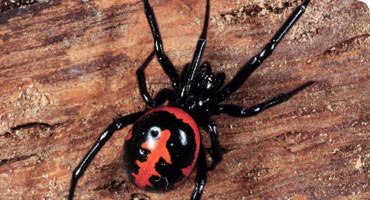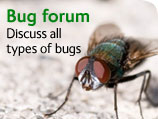False widow spider, Steatoda paykulliana
Body size
Female to 15mm; male to 7mm.
Appearance
Often mistaken for Latrodectus species because of its shiny, black, globose abdomen (see Steatoda grossa). Distinguished by the crescent-shaped band of red, orange or yellow at the front of the abdomen (photo). The male is smaller and slimmer than the female.
Habitat, range and season
Under rocks and stones, in buildings and plantations. S Europe, N Africa and W Asia. Adult females probably all year; adult males in spring and autumn.
Web
A tangle-web with taut threads bearing sticky globules.
Bite report
The bite of the female is toxic to mammals but the venom, apparently neurotoxic, is weaker than that of Latrodectus (Maretic et al., 1964).


